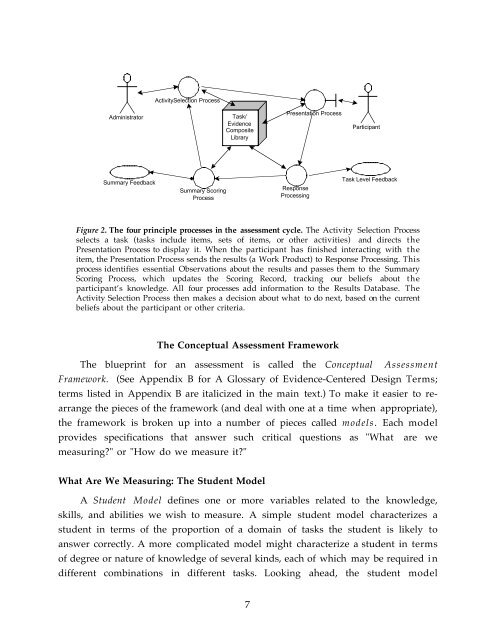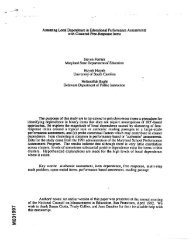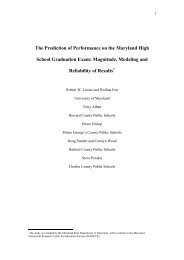A Brief Introduction to Evidence-Centered Design CSE Report 632 ...
A Brief Introduction to Evidence-Centered Design CSE Report 632 ...
A Brief Introduction to Evidence-Centered Design CSE Report 632 ...
You also want an ePaper? Increase the reach of your titles
YUMPU automatically turns print PDFs into web optimized ePapers that Google loves.
ActivitySelection ProcessAdministra<strong>to</strong>rTask/<strong>Evidence</strong>CompositeLibraryPresentation ProcessParticipantSummary FeedbackSummary ScoringProcessResponseProcessingTask Level FeedbackFigure 2. The four principle processes in the assessment cycle. The Activity Selection Processselects a task (tasks include items, sets of items, or other activities) and directs thePresentation Process <strong>to</strong> display it. When the participant has finished interacting with theitem, the Presentation Process sends the results (a Work Product) <strong>to</strong> Response Processing. Thisprocess identifies essential Observations about the results and passes them <strong>to</strong> the SummaryScoring Process, which updates the Scoring Record, tracking our beliefs about theparticipant’s knowledge. All four processes add information <strong>to</strong> the Results Database. TheActivity Selection Process then makes a decision about what <strong>to</strong> do next, based on the currentbeliefs about the participant or other criteria.The Conceptual Assessment FrameworkThe blueprint for an assessment is called the Conceptual AssessmentFramework. (See Appendix B for A Glossary of <strong>Evidence</strong>-<strong>Centered</strong> <strong>Design</strong> Terms;terms listed in Appendix B are italicized in the main text.) To make it easier <strong>to</strong> rearrangethe pieces of the framework (and deal with one at a time when appropriate),the framework is broken up in<strong>to</strong> a number of pieces called models. Each modelprovides specifications that answer such critical questions as "What are wemeasuring?" or "How do we measure it?"What Are We Measuring: The Student ModelA Student Model defines one or more variables related <strong>to</strong> the knowledge,skills, and abilities we wish <strong>to</strong> measure. A simple student model characterizes astudent in terms of the proportion of a domain of tasks the student is likely <strong>to</strong>answer correctly. A more complicated model might characterize a student in termsof degree or nature of knowledge of several kinds, each of which may be required indifferent combinations in different tasks. Looking ahead, the student model7






